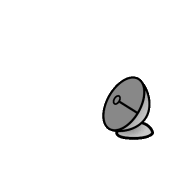
PicSat has been in India at the ISRO Sriharikota launch base since last month, and PicSat team members Mathias Lowak and Lester David have been on site to make sure that all is OK.
The launch is foreseen to happen on Friday 12 January at 4h48m AM Paris local time (9h28m local time in Shriharikota). It will happen on the PSLV (Polar Satellite Launch Vehicle) mission C40, together with a collection of other CubeSats and the larger Cartosat mission. After the ignition of the rocket, it should be about 20 minutes to reach the altitude of 505km where PicSat it to be released from its launch pod. The initialisation sequence is then automatically started, and 30 minutes later the antennas will deploy.
Then somewhere between 8 and 10 in the morning local time, we expect to receive a signal from PicSat as it passes of the Paris region.
We are all very excited with the prospect of having our satellite finally up in Low Earth Orbit soon!

Nous y voilà ! Le site PicSat est désormais disponible en français, pour ceux qui préfèrent la langue de Molière à celle de Shakespeare !
Les News, quant à elles, seront tantôt en Anglais, tantôt en Français, selon l’humeur de l’auteur… Au pire, il y a toujours Google traduction !
Pour accéder à cette version, il suffit de cliquer sur le drapeau tricolore situé en haut à droite de la page.

After a short appearance during the week-end of December 2 – December 3, 2017, our brand new PicSat website is finally coming back online !
This website describes the mission and its objective, and it will be used throughout the mission to provide a way for all radioamateurs listening to the satellite to upload the data they received, and collaborate to our mission.
Retrieving all the the photometry of Beta Pictoris 24/7 to detect an exoplanet or some exocomets passing in front of it will be hard. And we know that. But we hope that with the support of the community, we will be able to do just that!
We are in the final stage of our pre-launch activities in Meudon. PicSat is still on the ground, but it will soon fly to India and start its journey to space. In the meantime, we will connect this website to our “engineering model” (a spare copy of the satellite that we keep on ground), so that you can have an idea of what our data look like. Some maintenance has to be expected during the next few days.
But we promise: as soon as PicSat is in space, this website will show the true uncorrected raw data coming directly from it! We hope you’ll enjoy this opportunity to see how a space mission is operated, and to get an idea of the sparsity of data we have to deal with on a day-to-day basis…
Don’t forget to check our Twitter account IamPicSat for the latest news!
Yesterday we performed a fit check of PicSat in the QuadPack CubeSat dispenser (on the right).
The dispenser and PicSat will be ship separatly to India where we will put PicSat in the dispenser before the integration on the launch vehicle.
This test allows to avoid discomfiture on the launch pad in case of an external modification of the satellite which may block it in the deployer. For this test, PicSat was almost in flight configuration with a development detector which will be modified in the next days.
Building and testing a satellite is an Herculean task. Making reliable software is exceptionally time-consuming and requires a lot of hard work. Building a working ground station and making sure that it can track a satellite moving at 8km/s above our head is tough. Making sure that the science instrument can reach the level of precision required for detecting the transit of Beta Pic b, and creating a database reliable and efficient enough to store all the data is a challenge all by itself. And today, we are recalled that launching a satellite into orbit — the only thing we were taking for granted so far — is also terribly complex and difficult…
The Indian rocket PSLV-C39, which lifted-off on schedule from Sriharikota, suffered from some sort of malfunction (apparently, the fairing did not separate), leading to the failure of the mission. More can be read on Space News or the Times of India.
PicSat is supposed to be launched on the next PSLV (codenamed PSLV-C40). At that time, we have no real info on what will happen to C40. But it would not really be a surprise if it suffers some delay due to the failure of C39…
Yeah, space IS hard.
